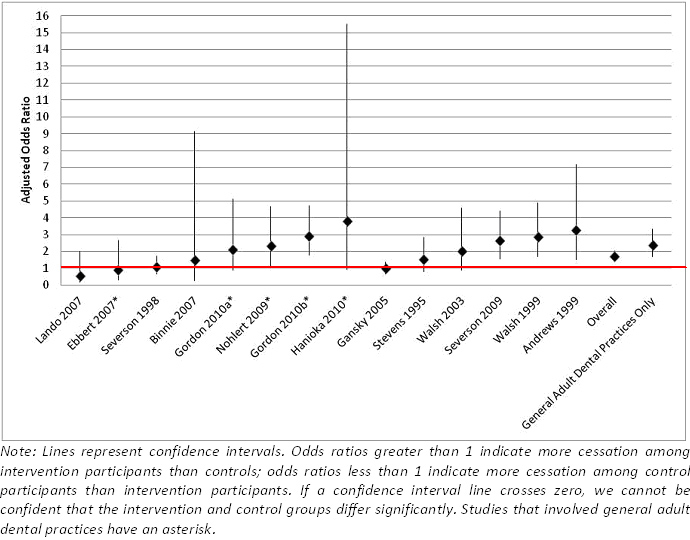In addition to respiratory and cardiovascular damage, tobacco use has severe adverse oral health effects including, cancer, oral disease, tooth decay, and diminished taste. Although dentists might be in a unique position to aid patients in achieving tobacco cessation, only 40% report such activities (Tomar, 2001). This issue of ASHES reviews a study by Carr and Ebbert (2012) that examined whether cessation interventions administered by oral health professionals in both dental and community settings are more effective than usual care regarding tobacco use.
Methods
- Researchers compiled data from fourteen randomized clinical trial studies. Each trial met the qualifications that the cessation intervention:
- Be run by oral healthcare professionals.
- Be held in a dental office or community setting
- Include some form of behavioral and/or pharmacological therapy
- Feature a follow-up at least six-months after the intervention
- Controls received either no intervention, usual care, or a brief, less extensive intervention, depending on the study.
- The outcome measure was percent of participants achieving tobacco cessation at the longest follow up for each trial.
Results
- Overall, the oral health professional administered cessation interventions significantly increased the odds of tobacco abstinence at 6 to 24 months compared to standard care, no care, or less treatment intensive care (odds ratio [OR] = 1.71, confidence interval [CI] = 1.44, 2.03).
- These results were burdened by a high rate of heterogeneity (i.e., individual studies varied significantly in their results: I2=61%).
- When the researchers analyzed only interventions occurring with adult patients in a general dental practice setting, the analyses revealed an even greater advantage of the intervention compared to standard care, no care, or less treatment intensive care (OR = 2.38, CI = 1.70, 3.35) with very little heterogeneity (I2=3%).

Figure. Results from individual and pooled studies. Click image to enlarge.
Limitations
• The individual studies that contributed to the overall estimate had very mixed results in the effects of their interventions.
• Tobacco cessation rates at follow up were self-reported, without verification.
Conclusion
Tobacco interventions by oral health professionals have a varying yet reliably positive influence on tobacco cessation. Dental practices that cater to adults are in a particularly strong position to affect tobacco cessation in adults. Future research needs to examine and identify the most critical components of an effective intervention in the dental setting.
–Nathaniel Finan
References
Carr, A. B. & Ebbert, J. (2012). Interventions for tobacco cessation in the dental setting. Cochrane Database Systematic Reviews 13(6).
Tomar, S. L. (2001). Dentistry’s role in tobacco control. Journal of the American Dental Association, 132(Suppl), 30S-35S.
What do you think? Please use the comment link below to provide feedback on this article.




